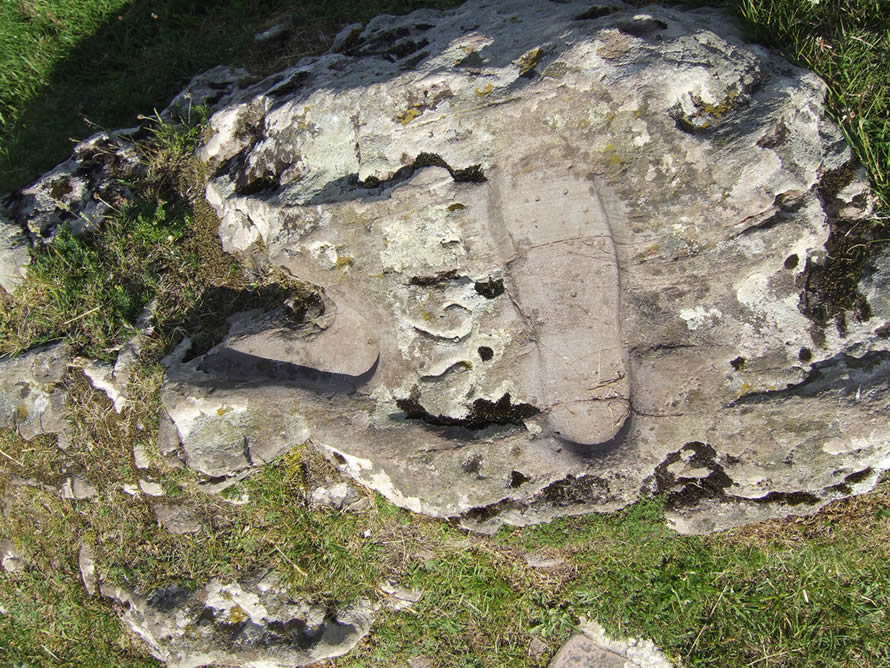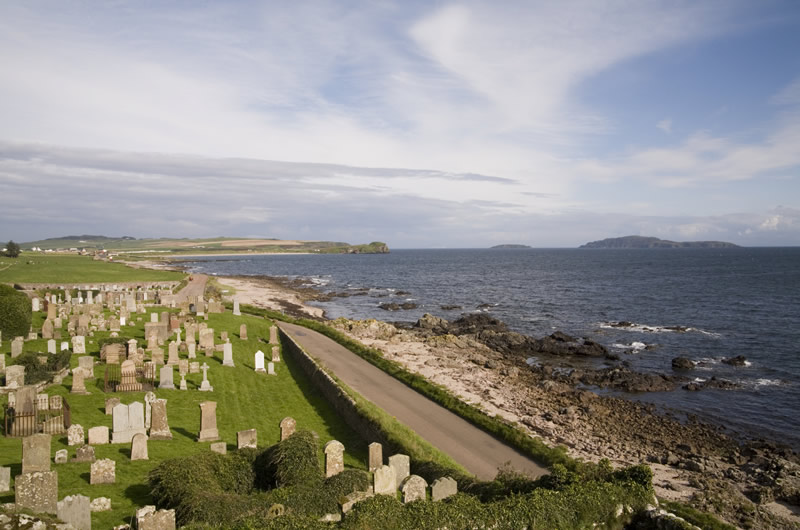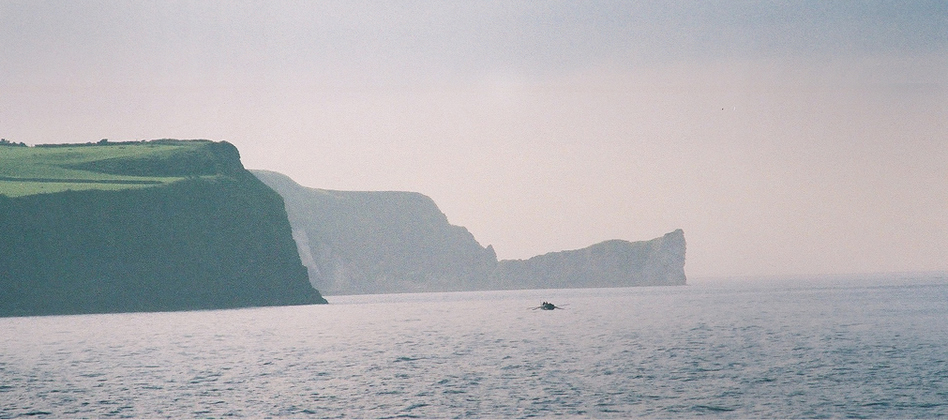6.7 Southend
Southend is said to be Colmcille’s first landing place in Scotland. He left Derry on the north coast of Ireland in 563 with 12 companions and landed here before heading up the Argyll coast to meet the king of the Dál Riata.
On a small mound to the west of the village there are two footprints set in a stone slab. According to tradition this marks where Colmcille first set foot on Scottish soil.
By sea, it is only 13 miles to the northeast coast of Ireland. On a clear day there are views to the fields and hills of Antrim.
Heading out of Southend towards High Keil, you will find a graveyard set around the ruins of the 13th century St Columba’s Chapel.
Just beyond the chapel, a path leads up to a small hillock. At the top two footprints have been cut into the rock.
One footprint is ancient and may have been used during the inauguration ceremonies of kings. The new king would have placed his foot in the hole as a sign that he would follow in the footsteps of his ancestors and that he was committing himself to the land.

Footprints like these have been found in sites all over Europe including Dunadd where there is another stone footprint linked to the kings of the Dál Riata.
The second footprint was carved into the rock in the mid 19th century.

The remains of St Columba’s chapel are mostly 13th and 14th century although people probably worshipped here before that date. There are medieval grave slabs on the floor of the chapel.

Why did Colmcille leave Ireland?
No-one knows exactly why Colmcille left Ireland. Writing 100 years after Colmcille’s death, his biographer Adomnán wrote,
‘Two years after the battle of Cul Drebene
[when] the holy man first set sail from
Ireland to be a pilgrim’
So one theory is that he left Ireland to be a Christian missionary. Legends also suggest that Colmcille was involved in a dispute over copyright which lead him to leave. Others say that he was so ashamed at his involvement with the Battle of Cul Dreimne in 561 that he felt compelled never to set foot on Irish soil again. There is also a tradition that he wanted to found his monastery in a place where he could not see Ireland.
Dunaverty rock and castle
Just south of the village of Southend there is a steep unusually-shaped headland with the remains of a castle probably dating from medieval times.
The first written record of a fortress here comes from the Annals of Ulster. The Annals describe a battle involving the king of the Dál Riata in 712.
The site is best known for a siege which took place in 1647 when 300 people were massacred.
Argyll
- 6.1 Dunadd
In the 6th century Dunadd was the power base and main fort of the local rulers - the Dál Riata. This rocky outcrop stands high on the Moine Mhor Great Moss with the River Add weaving around its base. Colmcille is thought to have visited the king of the Dál Riata at...
- 6.2 Kilmartin House Museum
Kilmartin House Museum is housed in the former manse of Kilmartin Church at the centre of Kilmartin village. Kilmartin Glen has an extraordinarily rich collection of 350 ancient monuments, all found within a six-mile radius of the museum. The area has a strong early Christian history and is closely connected to the...
- 6.3 Kilmartin Church
Kilmartin Glen is the site of more than 350 ancient monuments. These sites - which include 150 prehistoric monuments - lie within a six-mile radius of Kilmartin village. Yet this area has also played an important role in Scotland’s early Christian heritage. Just 5 miles south of here at Dunadd, the...
- 6.4 Keills Chapel & Graveyard, Keillmore
Keills Chapel sits up on a peninsular stretching out along the west side of Loch Sween. It dates from the 13th century but it is thought that people began worshipping here in the 8th century. As with Kilmory Knap Chapel across Loch Sween, this chapel does not have a direct link to...
- 6.5 Kilmory Knap Chapel
The chapel of St Mary at Kilmory Knap is on the east side of Loch Sween. Kilmory means 'the Church of (St) Mary'. From here there are clear views across to the island of Islay and Jura. It was built in the first half of the 13th century and now houses...
- 6.6 Cholmcille’s Chapel & Cave, Ellary
This peaceful location on the shores of Loch Caolisport is said to be where Colmcille stopped for a few days on his journey north from Ireland in 563. He was seeking a meeting with the local king, Conall mac Comgall, whose chief fort was about 15 miles from here at Dunadd....
- 6.7 Southend
Southend is said to be Colmcille’s first landing place in Scotland. He left Derry on the north coast of Ireland in 563 with 12 companions and landed here before heading up the Argyll coast to meet the king of the Dál Riata. On a small mound to the west of...










Bòrd na Gàidhlig
Great Glen House
Leachkin Road
Inverness
Scotland, IV3 8NW
(+44) 01463 225454
colmcille@gaidhlig.scot
Colmcille
Foras na Gaeilge, 2-6 Queen Street
Belfast
Northern Ireland
BT1 6ED
(+44) 028 9089 0970
colmcille@forasnagaeilge.ie
Colmcille
Foras na Gaeilge, An Chrannóg
Na Doirí Beaga
Gaoth Dobhair
Donegal, Ireland. F92 EYT3
(+353) 074 9560113
colmcille@forasnagaeilge.ie


